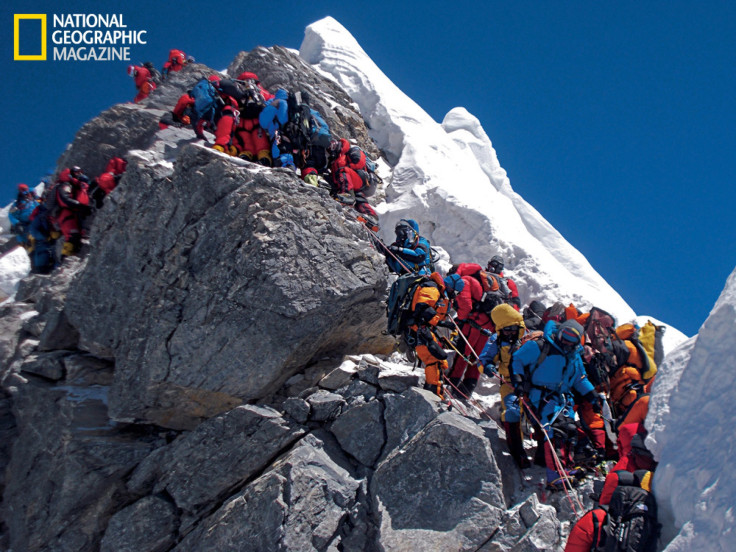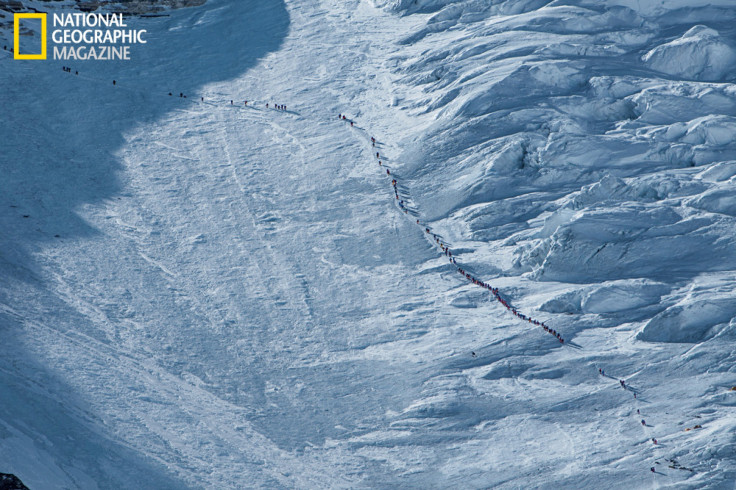Amateurs Invade Mount Everest: Long Lines On Top Of The World, But Some Reap The Benefits
When Mark Jenkins reached the summit of Mount Everest last year, he barely had space to take in the view. On May 25, 2012, the peak was buzzing with activity. Climbers were everywhere.
The highest point in the world might be the last place you’d expect to find a crowd of people. But last spring, more than 500 climbers made it to the summit of Everest -- most within the same short window of favorable conditions in late May. The head count just keeps on rising, year on year.
“It’s not the same experience; the standard route has become domesticated,” Jenkins said. “It has become declawed.”
This is old news to mountaineers. The extreme altitude and remoteness of Mount Everest -- it is 29,029 feet (8,848 meters) above sea level in eastern Nepal -- no longer deters even amateur climbers, provided they are wealthy enough to pay for a professional guide.
That doesn’t mean the risks of ascent have been mitigated. More than 230 people have lost their lives on Mount Everest, including 10 people last year and six during the 2013 climbing season.
It’s a sad story -- but not for everyone. Mount Everest adventurism brings a steady stream of revenue into one of the poorest countries in the world; it also brings more people face to face with one of nature’s greatest marvels.

For the past few years, the main route to Everest’s summit -- the Southeast Ridge, which begins in Nepal -- has been clogged with people during the few days each year when weather conditions are right for the attempt. That’s typically in the spring, just ahead of monsoon season.
The slow-moving throng seems out of place in such a majestic setting. During daylight hours, the adventurers make for a clumsy parade of colorful coats. At night, glowing lanterns bob in single file along a congested trail beneath a canopy of brilliant stars.
Many of the climbers who compose this traffic have limited experience; they simply hire guides to help them along, paying anywhere from $30,000 to $100,000. These clients are usually clipped onto a single fixed line -- a rope anchored into the mountain -- from which they cannot deviate, except in case of emergency.
That’s not to say the ascent is easy; far from it. The icy terrain can be unforgiving, and temperatures at the summit on a good day are around -15 degrees Fahrenheit, or -26 degrees Celsius. But it’s not the cold that gets you at first -- it’s the atmosphere, which grows thinner the higher you ascend. The lack of oxygen can cause intense fatigue or confusion. It also inhibits the body’s ability to keep warm.
“Grab a straw at your local coffee shop, put it in your mouth, and run up some stairs breathing only through the straw,” Jenkins said. “That’s what it’s like; your lungs are sucking for air.”
The vast majority of climbers use oxygen masks, but traffic on the mountain can slow them down so much that their oxygen supplies deplete to dangerous levels.
Ten people died on Everest last year -- Jenkins passed four of their corpses on the way up. Often, these tragedies result from hubris or naïveté; amateur climbers think a guide will make up for their own inexperience, and they put themselves in danger by failing to recognize their own limits.
That makes life difficult for the hired guides and porters who work to ensure their clients’ safety. On Everest, those guides are typically members of the Sherpa community, an ethnic group that has gained a reputation for their expertise, strength and hospitality in one of the world’s most unforgiving environments. Most Western visitors wouldn’t dream of climbing Mount Everest without their help.

“It’s hard for anyone to say they’ve climbed Everest alone,” Jenkins said. “These paying clients reach the summit on the backs of people who work hard for them. It’s different from other mountains where you might be doing everything for yourself; on Everest, on the standard route, the Sherpas are carrying your food, your tents and your oxygen up to the next camp.”
For Sherpas, the recent increase in adventurers on Everest certainly has its downsides. There is a greater demand for guidance, and that means more Sherpas are on the mountain at risk of injury or death. The traffic also leads to an increase in littering and pollution in Khumbu Valley.
But most Sherpa guides, porters, hotel owners and equipment purveyors aren’t complaining -- tourism has been a huge boon to local economies. The communities in the Khumbu Valley would be hard-pressed to find anything else approaching the level of revenue that Western climbers bring.
Mingmar Lama, owner of Nepal Sherpa Treks Ltd, which is based in Nepal’s capital of Kathmandu, has certainly noticed the uptick.
“A few days ago I was reading the news that there were more than 100 people at the summit on the same day,” he said. “That’s not normal. It’s funny; everybody is pushing to do the same thing. But it’s important that they have someone there to support them, so they don’t get disappointed after traveling thousands of miles to get here.”
Nepal Sherpa Treks helps visitors arrange tours and treks all over the region; Mount Everest Base Camp is one of its popular destinations. Lama and his staff help visitors with everything from itineraries to climbing gear; they have 100 to 150 clients annually.
“The tourism certainly does help us. It’s our primary source of income, and it has been supporting the Sherpa community for the last 40 years.”

The rest of Nepal’s economy is struggling with stagnation, mostly as a result of political instability. The country of 30 million has never fully recovered from a decade-long Maoist insurgency that ended in 2006. Today, about a quarter of the population lives in poverty, and income per capita stands around $750.
There are dozens of ethnic groups in Nepal, speaking dozens of different languages. Most people work as subsistence farmers, and Sherpas are no exception -- potatoes, first brought from Europe (where they were brought from South America), have been a popular crop since the 1800s.
But during the 20th century, those Sherpas who lived in the vicinity of the world’s tallest mountain used location to their advantage; they began doing business with visiting Westerners. A Sherpa named Tenzing Norgay made the first successful ascent and return from the summit of Mount Everest along with Sir Edmund Hillary of New Zealand in 1953, and the rest is history.
“Sherpas are one of the wealthiest ethnic groups in Nepal because of Western clients,” Jenkins said. “The last thing they want to see is Westerners stop coming to the Khumbu Valley.”
So while professional mountaineers may disapprove of the less-experienced climbers who now clog the main route on Mount Everest, the Sherpas who have been working as guides have good reason to look on the bright side.
“Because of all the people climbing, there’s a lot of media attention on Everest,” said Lama. “It ultimately helped to get more awareness about Nepal and trekking. Business has been good, and we are happy.”

In the end, even Jenkins isn’t too concerned about the situation on Everest -- in part because he never plans to go back.
“There are too many beautiful mountains that are unclimbed. I don’t need to go to Everest again,” he said. “It has the tallest peak, but for professional mountaineers the experience matters more than the summit. Every time you climb a mountain, you learn a little bit more about your geography, yourself, your fears, your weaknesses and your strengths. You really want to learn about yourself in a progressive way.”
Those who are less experienced may continue to set their sights on this one peak; their journey will be slow, and their presence will be an eyesore. But even they can boast an amazing achievement if they make it back to base, and there is no question that Sherpa communities ultimately benefit from their presence.
As long as these climbers are willing to take a chance on cheating death, the pull of the world’s highest peak is still strong -- even if Everest isn’t quite what it used to be.
Images in this article are from the June issue of National Geographic magazine. You can find Mark Jenkins's article on Everest traffic here.

© Copyright IBTimes 2024. All rights reserved.






















